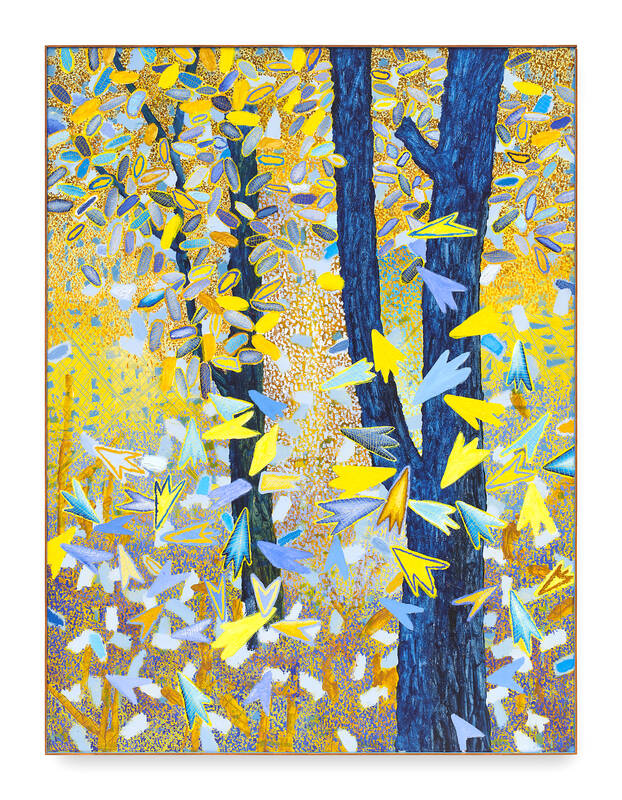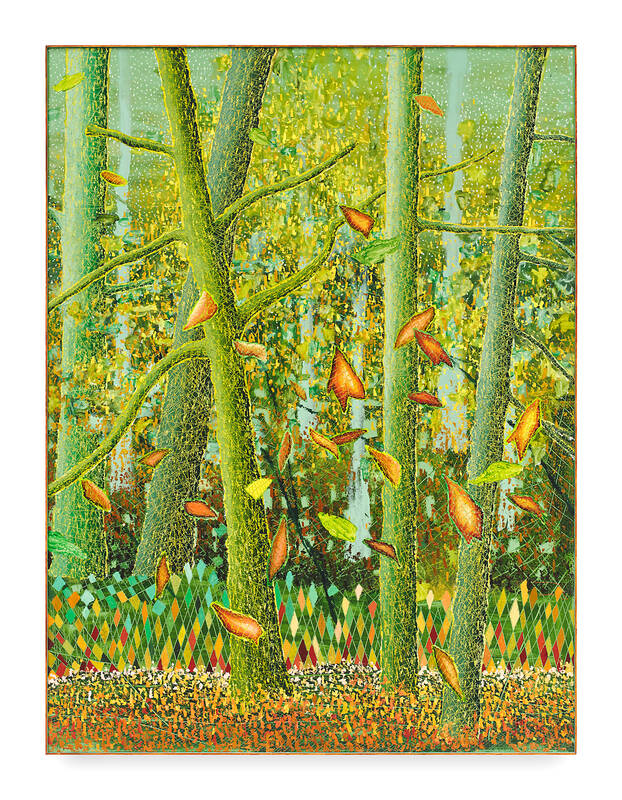Occupying the walls of an entire room of Asia Art Center’s (亞洲藝術中心) ground-floor gallery, Dawn Chorus — seven large canvas paintings depicting wild foliage, trees and forests — sing in unison of the inspirational beauty of the natural world.
“I painted them all at the same time,” LA-based artist Ross Caliendo tells the Taipei Times ahead of the exhibition opening, which was held on May 11 along with the opening of Exotica by Crystal Lupa (呂紹瑜), which is concurrently on show. “That way I could compare them and see how the different colors compliment and contrast with one another.”
The sense that the paintings are not just individual pieces but one conceptual work grows as you tour the room. One painting is deep green and autumnal, one fiery red and leafless, another purple, pink and evocative of spring. Yet all act as “a porthole to another world” as Caliendo puts it.

Photo: Thomas Bird, Taipei Times
According to the exhibition curators, these paintings were not just painted simultaneously but also “backwards,” a process that “involves the application of thick impasto over bright monochromatic underpainting in a contrasting color, that the artist then carves into with palette knifes, the back of brushes or other tools available in the studio to reveal the striking colors underneath.”
This unique approach, combined with a lifelong fascination with “color theory” as “reflected on the hue, value and chroma of his palette,” results in powerful interpretations of the flora that serves as the subject matter for the Dawn Chorus series.
PENNSYLVANIAN ORIGINS

Photo courtesy of Asia Art Center
While such artwork might reflect the lush valleys and blissful climate of California where Ross Caliendo lives and works, it feels a long way from the northern rustbelt city where he grew up.
“I’m actually from in Pittsburgh,” Caliendo, 36, says. “It’s an old industrial city. People say that it’s the sister city to Liverpool [in England].”
Despite being raised in an ostensibly blue-collar setting where “kids did sports,” Caliendo’s creative streak revealed itself early on.

Photo courtesy of Asia Art Center
“I was always doing creative things. I was the kid at school that could draw you the cartoon character that was popular on TV,” he says.
Curiously, Caliendo’s artistic abilities first provoked a desire to become a writer.
“I didn’t realize that the reason I wanted to be an author was because I was so interested in the covers of books. I was always making up these books so I could create the covers. Eventually, I figured out I wasn’t interested in writing but interested in drawing.”
Caliendo might have abandoned his literary aspirations early on, but a Tolkienesque other-worldliness combined with Henry David Thoreau’s naturalistic sensibilities invoke a poetic paradox in his work, one whereby the artwork appears to occupy the middle realm located somewhere between realism and fantasy.
“I don’t want to give the individual artworks names,” he says of the “untitled” paintings as we walk around the gallery space. “I let people decide what they are all about. I’m interested in energy and light, and I’ve just naturally come to this place where I’m using nature as an anchor.”
While Caliendo might not want to be too prescriptive about the meaning of his work, he does recall the time when he first saw the paintings that would go on to inform his art thereafter.
“When I was about 12 or 13 years old, my parents got me Saturday morning art classes at the Carnegie Museum of Art in Pittsburgh. A teacher took us around the museum. They had Egyptian art, medieval art, renaissance art right through to modern American art. And I remember there was work by [nineteenth century landscape painter] Winslow Homer and one by Willem de Kooning [a pioneering member of the twentieth century abstract impressionist movement]. These two types of paintings being right next to each other really blew me away. I didn’t understand how this naturalistic, beautiful painting could be placed next to this wild crazy splash of color. I found it inspiring because I just didn’t understand it. I realized then that being an artist was something that was possible. From that moment on, I was like, I’m just going to do that.”
Caliendo went on to undertake a Bachelor of Fine Arts (BFA) degree at Columbus College of Art and Design in Ohio, before relocating to Los Angeles, after briefly considering New York City as a base.
ART AS ENERGY
A decade in The Golden State had doubtlessly informed the artist’s work as light and nature are major elements in Caliendo’s paintings.
“The work is always transforming. I’m never really trying to say what the work is or isn’t about. Every piece is a journey and a reaction to the previous painting,” he explains of his process.
Living on the West Coast has also made him an established figure of the Pacific art scene, leading to opportunities across the pond, including Hong Kong and, of course, Taiwan.
“Melanie Ouyang Lum, who is one of the co-curators of this show, has been one of my major connections to the Asian art scene,” he explains. “I wouldn’t be here without her.”
But what does he think Taipei denizens will make of his multihued tree paintings on display in the concrete jungle of Neihu District (內湖)?
“I think nature is an amazing subject matter for artists ... because it is the closest thing to godliness,” he says.
“My hope is that the work sparks a sense of wonderment for being alive. I want the work to act as a catalyst, and a reminder that we are all together and present. I hope people connect with the work in that way.”

May 18 to May 24 Pastor Yang Hsu’s (楊煦) congregation was shocked upon seeing the land he chose to build his orphanage. It was surrounded by mountains on three sides, and the only way to access it was to cross a river by foot. The soil was poor due to runoff, and large rocks strewn across the plot prevented much from growing. In addition, there was no running water or electricity. But it was all Yang could afford. He and his Indigenous Atayal wife Lin Feng-ying (林鳳英) had already been caring for 24 orphans in their home, and they were in

President William Lai (賴清德) yesterday delivered an address marking the first anniversary of his presidency. In the speech, Lai affirmed Taiwan’s global role in technology, trade and security. He announced economic and national security initiatives, and emphasized democratic values and cross-party cooperation. The following is the full text of his speech: Yesterday, outside of Beida Elementary School in New Taipei City’s Sanxia District (三峽), there was a major traffic accident that, sadly, claimed several lives and resulted in multiple injuries. The Executive Yuan immediately formed a task force, and last night I personally visited the victims in hospital. Central government agencies and the

Australia’s ABC last week published a piece on the recall campaign. The article emphasized the divisions in Taiwanese society and blamed the recall for worsening them. It quotes a supporter of the Taiwan People’s Party (TPP) as saying “I’m 43 years old, born and raised here, and I’ve never seen the country this divided in my entire life.” Apparently, as an adult, she slept through the post-election violence in 2000 and 2004 by the Chinese Nationalist Party (KMT), the veiled coup threats by the military when Chen Shui-bian (陳水扁) became president, the 2006 Red Shirt protests against him ginned up by

As with most of northern Thailand’s Chinese Nationalist Party (KMT) settlements, the village of Arunothai was only given a Thai name once the Thai government began in the 1970s to assert control over the border region and initiate a decades-long process of political integration. The village’s original name, bestowed by its Yunnanese founders when they first settled the valley in the late 1960s, was a Chinese name, Dagudi (大谷地), which literally translates as “a place for threshing rice.” At that time, these village founders did not know how permanent their settlement would be. Most of Arunothai’s first generation were soldiers